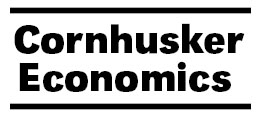Agricultural Economics, Department of

Cornhusker Economics
Date of this Version
12-3-2008
Document Type
Newsletter Issue
Citation
Cornhusker Economics
Abstract
In Cattle Today, an online beef producer’s magazine, a February 7, 2008 article titled “Preconditioned Calves Give Premium At Market” contained this statement, "We're weaning calves bigger and younger than we ever have. Many calves now weigh 600 to 700 pounds at weaning, whereas 20 or 30 years ago a yearling would weigh 600 to 700 pounds.” (http://www.cattletoday.com/archive/2008/February/CT1 411.shtml).
If you asked experts in the beef industry, you would probably get many different answers as to why calf size has increased. Some of the factors that probably have had an influence in increasing size include a better understanding of nutrition and health, as well as gains in genetics and management. Interestingly, this same periodical that cheered calf size as a contributor of profitability has also declared war on cow size. The following exerts are from an April 10, 2008 article titled “Optimum Cow Size Important For Efficiency.” “Over the past several decades the average cow on many ranches has increased in frame size, and in recent years some stockmen are realizing that their cattle have become too large to be efficient.” And “When we consider cow efficiency, a smaller cow will always have an advantage over a bigger cow. Smaller cows can do more for less. If your ranch can support 100 head of 1,400 pound cows, it will support 120 head of 1,100 pound cows – on the exact same inputs. That's 20 percent more cows producing 20 percent more calves – and I guarantee those 120 smaller cows will always produce more total pounds of beef than the 100 larger cows. On top of that, the calves out of the smaller cows (because they have smaller individual weights) will be worth more per pound.” http://www.cattletoday.com/archive/2008/April/CT1515. shtml


Comments
Published in Cornhusker Economics, 12-3-08. Produced by the Cooperative Extension, Institute of Agriculture and Natural Resources, Department of Agricultural Economics, University of Nebraska – Lincoln. http://www.agecon.unl.edu/Cornhuskereconomics.html